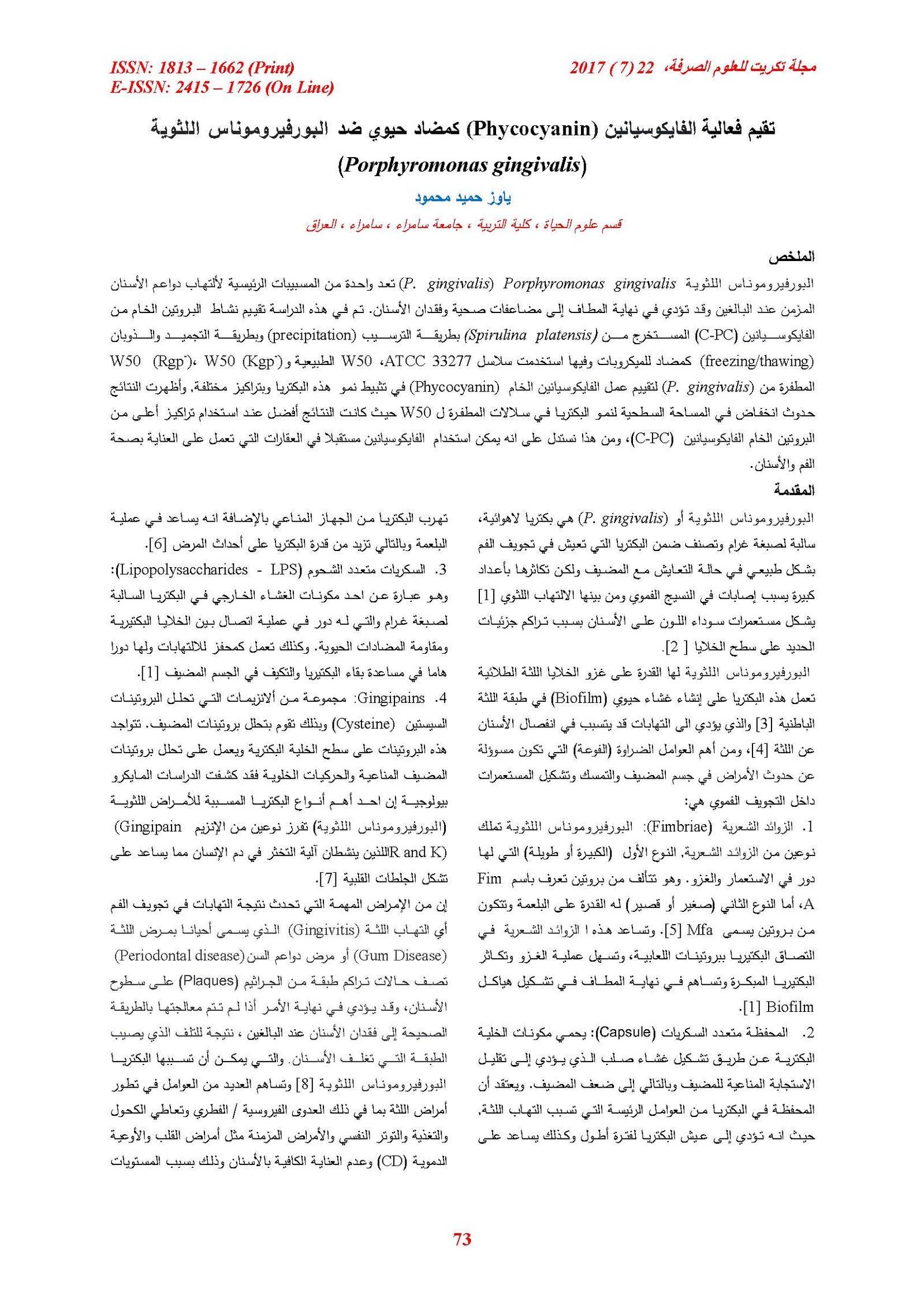Evaluation the effectivness of Phycocyanin as antibiotic against Porphyromonas gingivalis
Main Article Content
Abstract
Porphyromonas gingivalis (P. gingivalis) is considered as one of the major causes for periodontitis that eventually lead to health complications and teeth loss. In this study, crude protein extract of phycocyanin (C-PC) from Spirulina platensis that extract by precipitation and freezing/thawing methods, was assessed for its antimicrobial activity against its growth ATCC 33277, W50 wild type and W50 (Kgp-) W50 (Rgp-) mutant type P. gingivalis strains were used to evaluate C-PC action in the bacterial inhibition at different concentrations. The results showed that there was a decrease in ratio of the surface area for growth of bacteria has encountered in the W50 mutation strain at higher concentrations. This knowledge can be useful for the development of new oral hygienic treatments containing C-PC in the future
Article Details

This work is licensed under a Creative Commons Attribution 4.0 International License.
Tikrit Journal of Pure Science is licensed under the Creative Commons Attribution 4.0 International License, which allows users to copy, create extracts, abstracts, and new works from the article, alter and revise the article, and make commercial use of the article (including reuse and/or resale of the article by commercial entities), provided the user gives appropriate credit (with a link to the formal publication through the relevant DOI), provides a link to the license, indicates if changes were made, and the licensor is not represented as endorsing the use made of the work. The authors hold the copyright for their published work on the Tikrit J. Pure Sci. website, while Tikrit J. Pure Sci. is responsible for appreciate citation of their work, which is released under CC-BY-4.0, enabling the unrestricted use, distribution, and reproduction of an article in any medium, provided that the original work is properly cited.
References
1. Bostanci, N. & Belibasakis, G. (2012). Porphyromonas gingivalis: an invasive and evasive opportunistic oral pathogen. FEMS Microbiol. Lett., 333, 1-9.
2. Smalley, J. W., Birss, A. J., Szmigielski, B., & Potempa, J. (2006). The HA2 haemagglutinin domain of the lysine-specific gingipain (Kgp) of Porphyromonas gingivalis promotes micro-oxo bishaem formation from monomeric iron (III) protoporphyrin IX. Microbiology, 152, 1839-1845.
3. Katz, J., Onate, M. D., Pauley, K. M., Bhattacharyya, I., & Cha, S. (2011). Presence of Porphyromonas gingivalis in gingival squamous cell carcinoma. Int. J. Oral, Sci., 3, 209-215.
4. Aas, J. A., Paster, B. J., Stokes, L. N., Olsen, I., & Dewhirst, F. E. (2005). Defining the normal bacterial flora of the oral cavity. J. Clin. Microbiol. 43, 5721-5732.
5. Enersen, M., Nakano, K., & Amano, A. (2013). Porphyromonas gingivalis fimbriae. J. Oral Microbiol. 5-11.
6. Singh, A., Wyant, T., Anaya-Bergman, C., Aduse-Opoku, J., Brunner, J., Laine, M. L., Lewis, J. P. (2011). The capsule of Porphyromonas gingivalis leads to a reduction in the host inflammatory response, evasion of phagocytosis, and increase in virulence. Infect Immun, 79, 4533-4542.
7. Genco, C. A. P. J. M. Pawlinska, J. & Travis, J. (1999). Role of Gingipains R in the Pathogenesis of Porphyromonas gingivalis–Mediated Periodontal Disease. CID, 28, 456-465.
8. Genco, R. J., & Williams, R. C. (2010). Periodontal Disease and Overall Health: A Clinician’s Guide. Pennsylvania, USA: Professional Audience Communications, Inc.
9. Dyke, T. E. V.& Dave, S. (2005). Risk Factors for Periodontitis. J. Int. Acad. Periodontol., 7, 3-7.
10. Tribble, G. D. Kerr, J. E, & Wang, B.Y. (2013). Genetic diversity in the oral pathogen Porphyromonas gingivalis: molecular mechanisms and biological consequences. Future Microbiol., 8, 607-620.
11. Vincent, W. F. (2009). Cyanobacteria. QC, Canada: Elsevier Inc. Wenk, Markus R, & Fernandis, Aaron Zefrin. (2007). Protein Purification. A manual for Biochemistry protocols (Vol. 3, pp. 1-11): World Scientific Publishing Co. Ptc. Ltd.
12. Remirez, D., Ledon, N., & Gonzalez, R. (2002). Role of histamine in the inhibitory effects of phycocyanin in experimental models of allergic inflammatory response. Med. Inflamm. 11, 81-85.
13. Mahendra, J., Mahendra, L., Muthu, J., John, L., & Romanos, G. E. (2013). Clinical effects of subgingivally delivered spirulina gel in chronic
periodontitis cases: a placebo controlled clinical trial. J. Clin. Diag. Res. 7, 2330-2333.
14. Chen, T., Hosogi, Y., Nishikawa, K., Abbey, K., Fleischmann, R. D., Walling, J., & Duncan, M. J. (2004). Comparative whole-genome analysis of virulent and avirulent strains of Porphyromonas gingivalis. J Bacteriol, 186, 5473-5479.
15. Muthulakshmi, M., Saranya, A., Sudha, M., & Selvakumar, G. (2012). Extraction, partial purification, and antibacterial activity of phycocyanin from Spirulina isolated from fresh water body against various human pathogens. J. Algal Biomass, 3, 7-11.
16. Antelo, F. S., Anschau, A. Costa, J. A. V., & Kalil, S. J. (2010). Extraction and Purification of C-phycocyanin from spirulina platensis in conventional & integrated aqueous Two-Phase systems. J. Braz. Chem. Soc., 21, 921-926. 17. World Health Organization (WHO). (2012).Oral Health, http://www.who.int/mediacentre/factsheets/fs318
